Love to Hate: Rock-a-Doodle
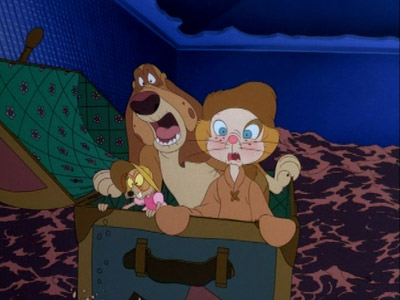 Author’s note: A version of this post originally appeared on my old site, The Ink and Pixel Club.
Author’s note: A version of this post originally appeared on my old site, The Ink and Pixel Club.
Back when I was blogging solo, I posted about a "How many of these animated movies have you seen" meme. Afterwards, I got an e-mail from my dad. He mostly wanted to share his reactions to animated films he had enjoyed, such as The Incredibles, The Triplets of Belleville, and WALL-E - which Dad thinks should have won Best Picture. (Have I mentioned that I love my dad?) But it wasn’t all praise. Dad also wanted to chide me for awakening his long dormant and thoroughly unpleasant memory of Don Bluth’s Rock-a-Doodle, a movie which he now remembers as being “god awful.”
After reading his e-mail, I decided that I had to rewatch Rock-a-Doodle and write about my impressions. Despite Dad’s negative memories and my own vague recollections of it being less than stellar, I tried to watch it with an open mind. I hadn’t seen it in over fifteen years. Had my father and I been unfair? Was this movie actually a flawed gem like The Secret of NIMH? Or was it really the cinematic disaster that my dad remembered?
The short answer? Dad was right.

Rock-a-Doodle kicks off with the story of Chanticleer, who gets his name from the character in the Reynard the Fox fables and in Chaucer’s Canterbury Tales. Chanticleer is a rooster with an appearance and voice reminiscent of Elvis Presley. (His vocals are provided by country singer Glen Campbell, Elvis having left the building over a decade before.) All of the farm animals believe that Chanticleer’s crow is what makes the sun rise, until one morning when Chanticleer misses his morning crow and the sun comes up regardless. Chanticleer’s barnyard pals label him a fraud and the crestfallen rooster leaves for the city, where he becomes a singing sensation.
Chanticleer could be an interesting character. He has a relatable problem: he believes his friends don’t care about him anymore and that the talent that made him special may have never even been real. His similarities to Elvis could have made for some entertaining moments. But despite a title and movie poster than feature him prominently, Chanticleer is not the protagonist of Rock-a-Doodle. He is more an object of pursuit. The good guys want to bring him back to the farm and the bad guys want to keep him away. Because as it turns out, Chanticleer’s crow really did keep the sun shining and the farm has been plagued with torrential rainstorms ever since he left. Realizing that they’re up a dell without a pitchfork, the farm animals set out to find Chanticleer and get him to come home. Chanticleer may be the guy with the power to solve the movie’s central problem, but he has so little screen time and character development that his role is almost reduced to "MacGuffin," more of a problem-solving device than a true character.
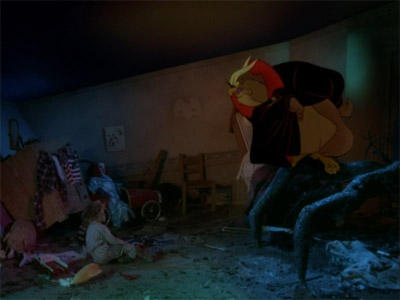
The movie’s actual protagonist is a little live-action boy named Edmond. Edmond lives on a live-action farm filmed with bad lighting and shaky camera work. Coincidentally, Edmond’s farm is also plagued by constant rain and his mother is trying to comfort him by reading him the story of Chanticleer.
There is very little to like about the live-action segments of the film. As I said, they aren’t shot well and the scenes that mix live-action and animation never look convincing, all the more disappointing when you consider that Who Framed Roger Rabbit premiered about three years earlier. The actors who play Edmond’s family turn in mediocre performances and Edmond ends up being one of the film’s biggest weaknesses.
Edmond is such a little “everyboy” that there is nothing distinctive or interesting about him. We don’t know if he likes to play sports or draw or ride horses, whether he is smart or gentle or kind or helpful. His main feature is that he’s cute and even that is a matter of opinion. For me, there is a very fine line between a character being genuinely cute and being an unnatural, fake attempt at cute. The characters that I find cute are cute because they behave in a way that is both appealing and very specific to who they are. This is not the case with Edmond. Edmond is the result of a child actor and a team of animators trying to hit all of the easiest stereotypical indicators for what is “cute.” Edmond has a cute little lisp. He gets turned into a cute little animated kitten. He has cute little fears and a cute habit of protesting that he isn’t afraid of anything. His supposed problem is that his family think he is too little to help protect the farm from the storm, a very child-specific, “cute” problem. All of this might add up to adorable for some viewers, but I find it about as authentic as Edmond’s pouty insistence that “I am…too one of the big boys!”, the pause giving him time to set his book down on his lap on the word “too” for emphasis. Like the entire performance, it feels forced.
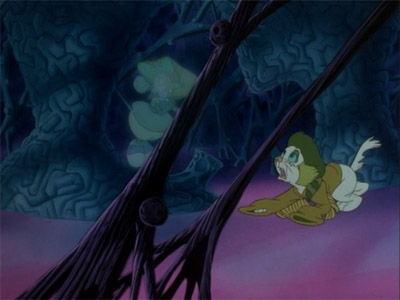
Because Edmond’s character is so unspecific, his problems and the skills he has to combat them are equally vague. Edmond’s main problem is the story’s main problem: the storm that threatens Edmond’s farm and Chanticleer’s farm. The personal issues that Edmond must overcome are not as evident. If they didn’t exist, that would be one thing. Not every good story has to feature a main character battling problems within and without. But the movie keeps hinting that Edmond does have a personal goal that he must reach. It just never makes it clear exactly what that goal might be. Does Edmond want to overcome his various fears? To stop believing that he is too small to do anything important? To win the respect of his family? I don’t know and I’m not sure the movie does either. Instead of seeing Edmond gradually move past his mental roadblocks or have a revelation on how to get past them, the audience gets a confusing scene where Edmond retreats into a mental realm, complete with brain columns and nerves strewn about, where he is haunted by faces and voices from the past hour or so. Edmond yells “No!” and suddenly emerges with the mental strength to go back to rescue one of his animal pals. It is a confusing metaphor for Edmond conquering his nonspecific fears.
One of the movie’s problems is the lack of any relationship between its two most important characters. In fact when they finally meet, about ten minutes before the end of the film, a confused Chanticleer asks Edmond “Well who are you?” The movie feels like two stories loosely connected by a group of farm animals. Chanticleer’s story, which seems like it would be the more interesting of the two, ends up getting squeezed to the point where one of the character’s major problems – he no longer has the self-confidence to crow – doesn’t come up until mere minutes before it is resolved. Instead of focusing on Chanticleer’s loneliness and lack of confidence in spite of living the life of a rock star, the film centers on Edmond and his ill-defined issues. Despite some attempts to draw parallels between their problems, including a scene where Chanticleer is also haunted by voices from his past, Edmond and Chanticleer just don’t feel connected. The movie pushes aside its strongest character to make room for a weaker one.
Edmond’s lack of power or skills makes creating a satisfying narrative difficult, but not impossible. There certainly have been films where the protagonist is neither the hero not a terribly strong character, Disney’s earlier “princess” films among them. But these films made up for their passive protagonists by populating the movie with strong and interesting supporting characters who could drive the plot while leaving the protagonist free to wish and hope and dream. But Edmond is not just the protagonist of Rock-a-Doodle; he is also supposed to be the hero. That means that virtually every other character in the movie has to be less capable than Edmond, and you can just imagine how much fun that’s going to be.
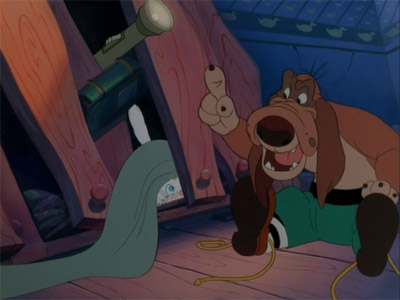
After the Grand Duke – the villain from the Chanticleer story - transforms him into an animated kitten, Edmond meets the animals from Chanticleer’s farm. Chief among them is Patou, the old farm dog. Patou is voiced by Phil Harris, who also voiced Baloo from The Jungle Book and several other Disney characters. Casting Harris feels like an attempt to connect Rock-a-Doodle to the classic Disney films. The name “Patou” even sounds a bit like “Baloo.” But unfortunately, the man who helped to transform a bit-player bear into the heart and soul of The Jungle Book could not do the same for Patou the dog. It’s not that there’s anything wrong with Harris’s performance, there just isn’t enough meat to the role. Patou begins the movie by telling the audience that this is a story from “back before I knew how to tie my shoes,” which sounds like a folksy way of saying “when I was young.” But Patou is a pucker-faced old dog when we meet him. The bit about not knowing how to tie his shoes? That’s actually Patou’s entire shtick. Patou is a dog who doesn’t know how to tie his shoes. It’s never presented as a metaphor for anything, given any emotional weight, or made to have any bearing whatsoever on the plot. Why is this detail in the movie at all? Well, Edmond knows how to tie shoes and if Edmond is going to have a prayer of coming across as the hero, he needs every chance he can get to show why the other characters need him around.
Oh and were you wondering why Patou wears shoes to begin with? Is it because some of the other animals also have shoes? No. Is it because he’s already wearing pants and socks and shoes complete the look? No. Patou wears shoes because Patou has bunions, lots and lots of bunions. The shoes help his feet feel better. There, now aren’t you sorry you asked?
Patou also serves as the movie’s narrator, a role that I’m guessing he was given to make sure that the littlest members of the audience could follow the story. Patou doesn’t just explain how Chanticleer ended up leaving the farm; he pops up throughout the film to narrate. His comments range from obvious to confusing to spoilers within the movie itself. We can clearly see Chanticleer performing on stage in front of screaming fans. So why do we need Patou to interrupt the song to inform us that “Chanticleer had become a star”? Why does Patou feels the need to tell us that Chanticleer “maybe wasn’t the smartest bird that ever lived” when Chanticleer never does anything to suggest that he is particularly dumb? Patou’s introduction of Goldie, the pheasant chorus girl who becomes Chanticleer’s love interest, is particularly over-informative. Patou not only tells us that Goldie is jealous of Chanticleer’s meteoric rise to fame, but also goes on to make sure we know that Goldie will turn out to be a lot nicer (which we can see for ourselves later on) and smarter (which is never particularly evident) than she initially seems. The impression that I get is that I am watching a movie that could not be trusted to tell its own story without one of the characters constantly stepping in to explain everything.
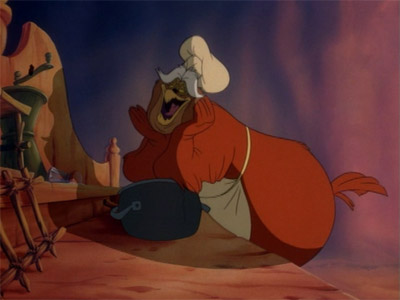
Heading up the movie’s bad guys is the Grand Duke, the leader of the photophobic owls. The Duke caused Chanticleer’s departure by sending another rooster to stop Chanticleer from crowing. The rooster calls Chanticleer out for a fight, tussles with him, and is never seen again. Why a rooster? Why not an owl who might actually show up again, since the fight takes place just before dawn? Beats me. Anyway, the fight causes Chanticleer to miss his regularly scheduled crowing, which leads to the sun coming up without him. In an incredible stroke of good luck for the Duke, once Chanticleer leaves and ceases crowing, the sun stops shining. I say "luck" because I can’t see how the Duke could possibly plan for the sun to rise once without Chanticleer crowing, the other animals to mock Chanticleer, Chanticleer to leave the farm, and the sun to cease shining after that.
The Duke is not a terribly frightening villain to anyone over the age of four. He’s just a pudgy old owl who’s too busy mugging for the camera and enjoying his own sarcastic humor to be truly scary. The Great Owl in NIMH - a supposed “good guy” – is far more terrifying. The one thing the Duke has that makes him a real threat is magic and even that he uses mostly to do things that aren’t scary, like growing bigger or turning Edmond into a kitten or hitting Chanticleer over the head with mallet. In spite of this, test audiences found the red smoke that the Duke emits from his mouth to perform magic too frightening, so in the final film, the smoke is dotted with fluorescent Lucky Charms. The Duke still maintains a creepy expression in a few shots and strangles Edmond before the end of the film. But for the most part, the Duke is reduced to putting his face very close to the camera in an attempt to elicit the occasional scare.
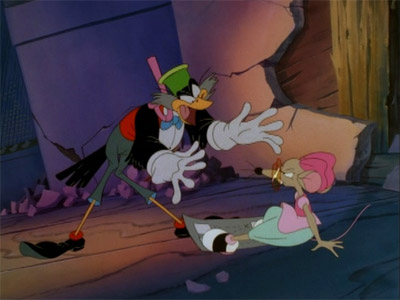
The rest of the cast doesn’t fare much better than the major players. Edmond has two other animal pals who join him in the search for Chanticleer: Peepers the brainy mouse and Snipes the annoying magpie. Peepers is smart, which for the purposes of this film means that she knows how to drive a car, can pilot a helicopter, uses the occasional big word, and wears glasses. What she can’t do is lead the animals to the city, because then Edmond would have nothing useful to do. The movie tries to develop some kind of friendship between Edmond and Peepers. It seems like a good idea: Edmond lacks self-confidence (I think) and is feeling even less capable now that he’s a kitten, while Peepers is smaller than Edmond but has no doubt about her ability to do whatever she needs to. And they both have lisps, though hers – provided by the voice of Vixey from Disney’s The Fox and the Hound, Sandy Duncan - is less annoying. But their friendship never develops beyond Edmond whining that he’s too little to do something, Peepers pointing out that she’s not too little, and Edmond going ahead and doing the thing. And the speech impediment connection is never mentioned.
Snipes the magpie is not so much a character as an assortment of quirks, with a new one tossed in whenever the movie requires something funny to happen. In one scene, he’s suffering from claustrophobia. In the next, he’s gushing about his love of food. None of these traits ever gel into a fully realized character. His one consistent trait is that he’s kind of a jerk. He’s constantly bickering with Peepers, though we never know why, making their eventually reconciliation hollow. Snipes never contributes a thing to the plot. His role is strictly comic relief and since he’s not particularly funny, he could have easily been cut.
The Grand Duke has his own entourage to combat Edmond’s scrappy band of critters. Pinky the fox serves as Chanticleer’s Colonel Tom Parker. He's also working for the Grand Duke, though I can’t figure out how the business relationship benefits either of them until the plot makes it necessary for them to know each other. If the Duke really wants to ensure that Chanticleer never crows again, wouldn’t he want his henchmen to focus on killing Chanticleer rather than turning him into a successful singer? And what does Pinky need from the Duke when he has Chanticleer to help him rake in profits?
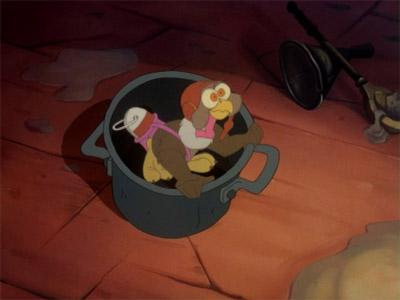
Closer to home, the Duke is in command of of several anonymous owls and his diminutive nephew Hunch. Hunch is an incompetent little owl with a habit of spouting “a” words ending in “-ation”: “annihilation,” “abomination,” “aggravation.” This is not funny, nor does it make an ounce of sense. There is a potentially amusing gag where the smoke from the Grand Duke’s mouth changes Hunch into different creatures whenever the Duke gets angry with him. But since it is only used twice and one of the forms Hunch ends up with looks like some bizarre cross between an owl and a pickle, the opportunity for comedy is wasted.
You would think that a movie about a rooster who looks and sounds like Elvis Presley would be a great musical just waiting to happen. With a whopping twelve songs in the film – thirteen if you count the reprise of the pleasant opening number “Sun Do Shine” at the end – you also expect to hear a lot of Glen Campbell crooning like the King. But that’s not the case. Only half of the film’s songs are sung by Chanticleer and of those, there are only three which can really be counted as complete songs. In addition to “Sun Do Shine,” Chanticleer performs the film’s title song and “Treasure Huntin’ Fever.” Neither are great and the latter suffers from such clunky lyrics as “I got treasure-huntin’ fever for love,” but they do make for some of the movie’s better set pieces. Aside from that, you get one Chanticleer song that is cut off just a few lines in and two that are sung in their entirety, but are impossible to hear all the way through. Why? Because Patou talks over them. “Come Back To You” sounds like a pretty song, but I can’t say for certain because I can only hear a few snippets behind Patou’s gabbing. “Kiss ‘N’ Coo,” Chanticleer and Goldie’s love duet, has the added distraction of Edmond and his friends watching the pair from afar and discussing their situation, drowning out most of the music that Patou hasn’t already talked over.
Most of the remaining songs are short little ditties, lasting a minute or less. They don't enhance the film or offer new information. The Grand Duke and his owls get three awful songs including one where the lyrics are literally “Tweedle-lee-dee, tweedle-lee-dee. They’re running out of batteries.” Perhaps the theory was that if the villains’ songs were terrible, Chanticleer’s would sound that much better. But all it does is bog down the film with yet more pointless musical numbers that are outright bad to boot. Poor Goldie only gets to sing two lines of her solo number before it gets cut off. I’m not sure if the decision was made to avoid having three songs right in a row or to cut down on Goldie’s screen time. Another complaint from test audiences was that Goldie was too shapely and seductive looking for a character in a kiddie flick. Cutting her song may have saved the animators some work as they toned down her figure. Chanticleer’s bouncers have an utterly pointless song. And over the end credits, Patou gets a song about – what else? – tying his shoes.
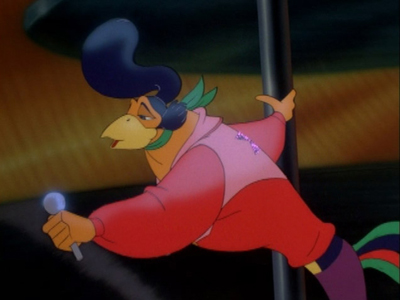
I think what surprised me most about this movie is how outright dull it is. Oh sure, there are action scenes and chases and the like. And the animators still know how to pull off some visual excitement here and there. The “Rock-a-Doodle” musical number has some fun with Chanticleer performing atop a giant record player and there’s an entertaining shot where the camera goes through the hole in the center of a record that Pinky is spray-painting gold back to Chanticleer’s performance. The opening shot in the movie has the camera dropping down from above the clouds, racing between haystacks and cornstalks and up a hillside before finally coming to rest on Chanticleer’s face as he crows. It’s technically impressive, but something has been lost between Bluth’s earlier films and this one. Maybe there wasn’t enough time, enough money, or enough enthusiasm. I just don’t see the extra flourishes that made NIMH such a visual treat. The character designs are frequently unappealing and the colors often read as garish, a far cry from the subtle tones and dozens of palettes per character of Bluth movies past. Stronger visuals may not have saved the film from its story problems, but they would have at least made it fun to look at.
I realize I am not the target audience for this movie. I was probably too old for it back in 1991 when it premiered. So is it fair of me to be so critical of a film for young children? I think so. Some of my very favorite animated films are ostensibly intended for children or “families,” and yet I keep coming back to them as an adult and enjoying them. Nostalgia is probably a part of it, but the best of them are the ones that continue to entertain or amaze me as an adult, whether through visuals from animators who were among the best in the business or stories that still hold up and even offer new revelations as I grow older.
I know going in that a lot of animated films I see are going to end happily. I may know where the movie will end up, but I don't always know how it will get there. And if I care about the characters and what they're going through, then the movie matters to me. Rock-a-Doodle never convinced me to care about its characters. I was always well aware that Chanticleer would get back to the farm and crow, the sun would come up again, the owls wouldn’t eat all those cute little farm animals, and Edmond would neither die nor live out his days as a cat. Not only did I know these things would happen, I didn’t care. It doesn’t matter to me that Goldie comes to live on the farm with Chanticleer when her character never advances beyond “stereotypical blonde airhead.” It doesn’t matter to me that Peepers and Snipes become friends because I never knew why they didn’t like each other to begin with. And it certainly never mattered to me whether or not Patou learned to tie his shoes.
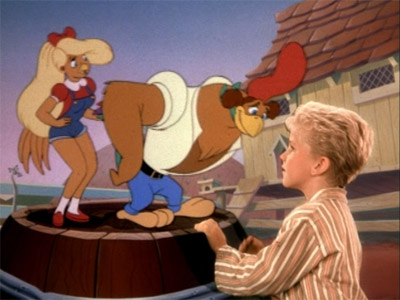
Children might enjoy Rock-a-Doodle, but I see no reason to show it to them. Kids are no less deserving of intelligent movies with well thought out stories and interesting characters than adults are. To forgive the flaws in Rock-a-Doodle on the grounds that it’s a movie for kids and kids don’t care about plotholes or story structure is both selling kids short and delivering a slap in the face to every movie that is well crafted and enjoyable for kids and adults alike. As my dad helpfully pointed out, parents have to watch these movies too and the films that can truly entertain viewers of every age have a much better chance of standing the test of time. Rock-a-Doodle is one forgotten film that is best left that way.
